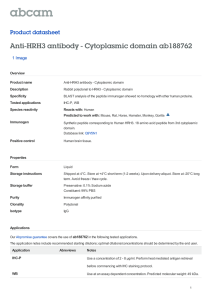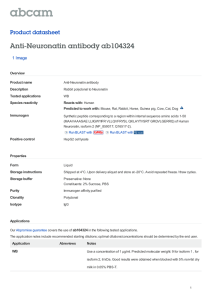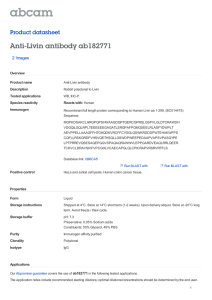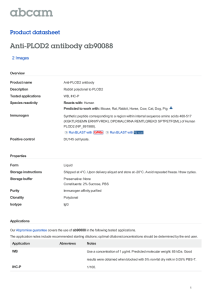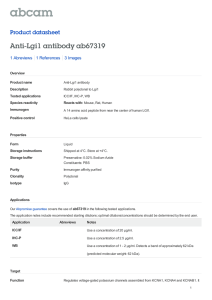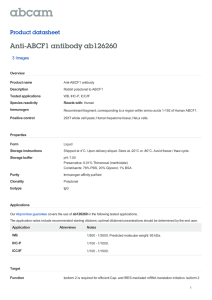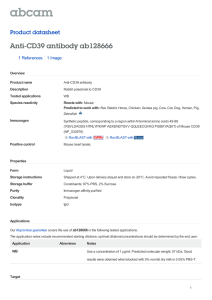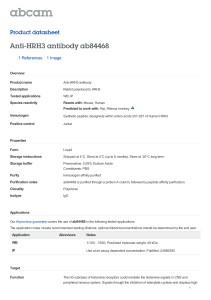Anti-HRH3 antibody - Cytoplasmic domain ab188972 Product datasheet 2 Images Overview
advertisement
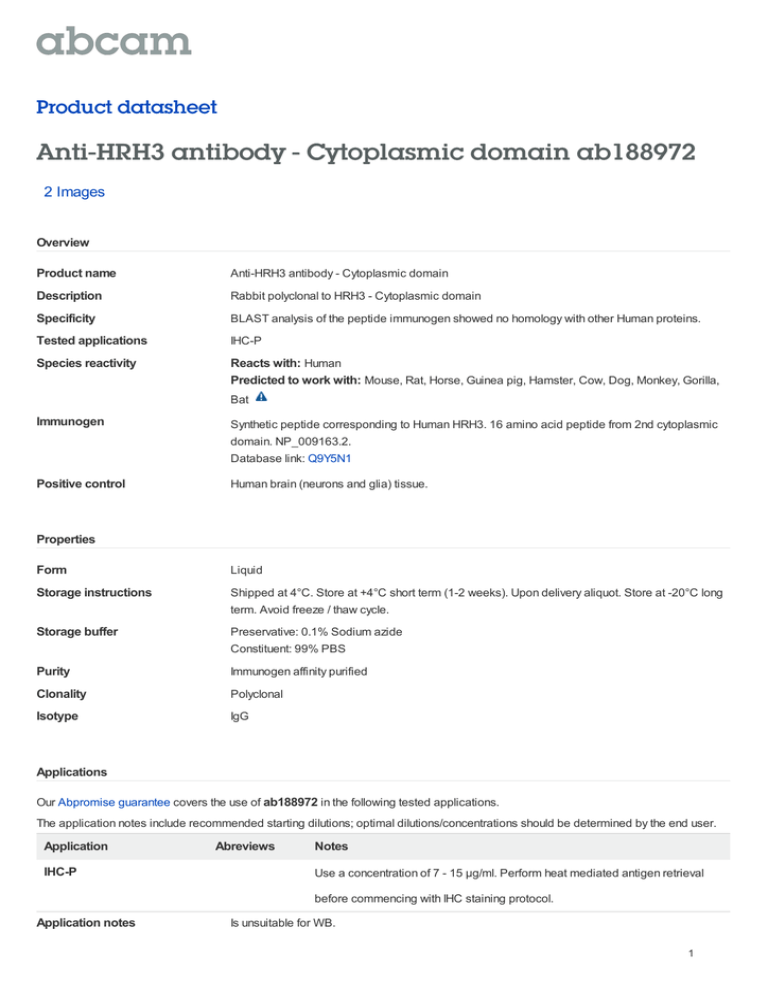
Product datasheet Anti-HRH3 antibody - Cytoplasmic domain ab188972 2 Images Overview Product name Anti-HRH3 antibody - Cytoplasmic domain Description Rabbit polyclonal to HRH3 - Cytoplasmic domain Specificity BLAST analysis of the peptide immunogen showed no homology with other Human proteins. Tested applications IHC-P Species reactivity Reacts with: Human Predicted to work with: Mouse, Rat, Horse, Guinea pig, Hamster, Cow, Dog, Monkey, Gorilla, Bat Immunogen Synthetic peptide corresponding to Human HRH3. 16 amino acid peptide from 2nd cytoplasmic domain. NP_009163.2. Database link: Q9Y5N1 Positive control Human brain (neurons and glia) tissue. Properties Form Liquid Storage instructions Shipped at 4°C. Store at +4°C short term (1-2 weeks). Upon delivery aliquot. Store at -20°C long term. Avoid freeze / thaw cycle. Storage buffer Preservative: 0.1% Sodium azide Constituent: 99% PBS Purity Immunogen affinity purified Clonality Polyclonal Isotype IgG Applications Our Abpromise guarantee covers the use of ab188972 in the following tested applications. The application notes include recommended starting dilutions; optimal dilutions/concentrations should be determined by the end user. Application IHC-P Abreviews Notes Use a concentration of 7 - 15 µg/ml. Perform heat mediated antigen retrieval before commencing with IHC staining protocol. Application notes Is unsuitable for WB. 1 Target Function The H3 subclass of histamine receptors could mediate the histamine signals in CNS and peripheral nervous system. Signals through the inhibition of adenylate cyclase and displays high constitutive activity (spontaneous activity in the absence of agonist). Agonist stimulation of isoform 3 niether modified adenylate cyclase activity nor induced intracellular calcium mobilization. Tissue specificity Expressed predominantly in the CNS, with the greatest expression in the thalamus and caudate nucleus. The various isoforms are mainly coexpressed in brain, but their relative expression level varies in a region-specific manner. Isoform 3 and isoform 7 are highly expressed in the thalamus, caudate nucleus and cerebellum while isoform 5 and isoform 6 show a poor expression. Isoform 5 and isoform 6 show a high expression in the amygdala, substantia nigra, cerebral cortex and hypothalamus. Isoform 7 is not found in hypothalamus or substantia nigra. Sequence similarities Belongs to the G-protein coupled receptor 1 family. Cellular localization Cell membrane. Anti-HRH3 antibody - Cytoplasmic domain images Immunohistochemical analysis of formalinfixed, paraffin-embedded Human brain (neurons and glia) tissue, labeling HRH3 with ab188972 at 15 µg/ml. Immunohistochemistry (Formalin/PFA-fixed paraffin-embedded sections) - Anti-HRH3 antibody (ab188972) Immunohistochemical analysis of formalinfixed, paraffin-embedded Human brain (neurons) tissue, labeling HRH3 with ab188972 at 15 µg/ml. Immunohistochemistry (Formalin/PFA-fixed paraffin-embedded sections) - Anti-HRH3 antibody (ab188972) Please note: All products are "FOR RESEARCH USE ONLY AND ARE NOT INTENDED FOR DIAGNOSTIC OR THERAPEUTIC USE" Our Abpromise to you: Quality guaranteed and expert technical support Replacement or refund for products not performing as stated on the datasheet 2 Valid for 12 months from date of delivery Response to your inquiry within 24 hours We provide support in Chinese, English, French, German, Japanese and Spanish Extensive multi-media technical resources to help you We investigate all quality concerns to ensure our products perform to the highest standards If the product does not perform as described on this datasheet, we will offer a refund or replacement. For full details of the Abpromise, please visit http://www.abcam.com/abpromise or contact our technical team. Terms and conditions Guarantee only valid for products bought direct from Abcam or one of our authorized distributors 3
